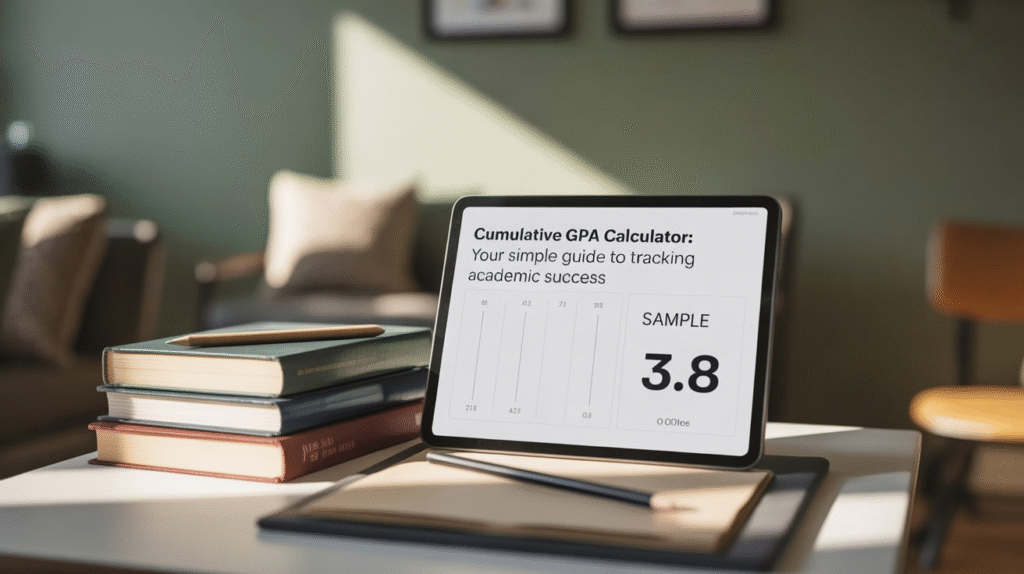Ever wondered what your GPA really means or why teachers and colleges talk about it so much? Your Grade Point Average (GPA) is a number that shows how well you’re doing in school. It’s like your academic scorecard—a quick way to measure your progress over time.
Now, when you add up all your grades from every semester or year, you get your cumulative GPA. Keeping track of this number helps you stay focused, plan your studies, and set smart goals.
That’s where a cumulative GPA calculator becomes super helpful. It’s an easy tool that does all the math for you, showing your real average in seconds. Whether you’re in middle school, high school, or college, understanding how to use one can make a big difference in your academic journey.
What Is a Cumulative GPA Calculator?

A cumulative GPA calculator is a simple online tool that helps you find your total average grade across multiple semesters or school years. Instead of calculating each term’s GPA separately, it combines all your grades, credits, and classes into one final number.
For example, if you’ve taken classes in different years—like math, science, and English—your cumulative GPA calculator adds everything together to show your overall academic performance.
This tool saves you time and prevents math mistakes. You don’t need to guess or write long formulas. Just enter your course names, grades, and credit hours, and the calculator instantly gives your cumulative GPA.
How a Cumulative GPA Calculator Works

Let’s break it down step-by-step. Most cumulative GPA calculators use the same basic formula:
Cumulative GPA = (Total Grade Points Earned ÷ Total Credit Hours Attempted)
Each letter grade (like A, B, C) has a specific point value. For example:
- A = 4.0 points
- B = 3.0 points
- C = 2.0 points
- D = 1.0 point
- F = 0 points
When you enter your grades and credits, the calculator multiplies each grade’s point value by its credit hours. Then it adds all those up and divides by the total number of credits you’ve taken.
In seconds, you’ll know exactly where you stand. No complicated spreadsheets or guesswork needed!
Why You Should Use a Cumulative GPA Calculator
Using a cumulative GPA calculator helps you understand your academic strengths and weaknesses. It gives you a clear picture of your progress so you can plan smarter.
Here are some key benefits:
- Saves time: You don’t have to manually calculate every semester.
- Shows trends: You can see whether your GPA is improving or dropping.
- Helps with planning: Knowing your current GPA helps you set goals for future semesters.
- Useful for scholarships: Many scholarships have GPA requirements.
- Prepares you for college or job applications: A strong GPA shows commitment and consistency.
In short, it’s more than just a number—it’s a snapshot of your academic journey.
How to Use a Cumulative GPA Calculator Step-by-Step

Using one is easier than you might think! Here’s how you can do it:
- Collect your grades and credits: Find your transcript or report card.
- Enter each class: Type in the class name, grade, and credit hours.
- Choose your grade scale: Most schools use a 4.0 scale.
- Add all semesters: Include all courses from every term.
- Click calculate: The tool instantly shows your cumulative GPA.
Tip: Many online calculators let you update your GPA every semester, so you can track your progress easily.
Understanding Weighted vs. Unweighted GPA
Not all GPAs are the same. Schools often use either weighted or unweighted GPAs.
An unweighted GPA uses a 4.0 scale. Every A is worth 4 points, no matter how hard the class is.
A weighted GPA, on the other hand, rewards tougher classes. Advanced Placement (AP), Honors, or IB classes may count as 5.0 or higher for an A.
When using a cumulative GPA calculator, make sure you choose the correct type. Mixing up weighted and unweighted grades can give you the wrong result.
How Colleges and Employers View Your Cumulative GPA
Colleges and employers see your cumulative GPA as proof of your dedication and work ethic. It’s one of the first things they notice on an application.
A high cumulative GPA shows you’ve worked hard and stayed consistent. It tells colleges that you’re ready for advanced courses. Employers see it as a sign of reliability and effort.
But remember: your GPA isn’t everything. It’s just one piece of your story. Your activities, volunteer work, and personality also matter a lot. Still, keeping your GPA high can open many doors.
Tips to Improve Your Cumulative GPA
Want to raise your GPA? Here are some simple, effective tips:
- Stay organized: Keep track of assignments, tests, and deadlines.
- Ask for help: Teachers, tutors, and study groups can make a big difference.
- Prioritize tough classes: Spend more time on subjects you find challenging.
- Use a GPA tracker: A cumulative GPA calculator helps you monitor your progress every term.
- Don’t give up: Even small grade improvements can raise your overall GPA.
Remember, your GPA reflects effort over time. Be patient and consistent—you’ll see results!
Common Mistakes When Calculating Your Cumulative GPA
Even smart students make mistakes when doing GPA math manually. Here are some errors to watch out for:
- Forgetting to include all classes (even electives count!)
- Using the wrong grade scale (weighted vs. unweighted)
- Mixing up credit hours
- Rounding numbers too early
- Not updating GPA after each term
A cumulative GPA calculator eliminates most of these errors automatically. That’s why it’s always a smart idea to use one instead of calculating by hand.
Best Free Cumulative GPA Calculators Online
There are many great tools online that make GPA tracking super easy. Some of the most popular include:
- CollegeSimply GPA Calculator
- Calculator.net GPA Calculator
- RapidTables GPA Calculator
- GPACalculator.io
Each one works slightly differently, but the process is similar. You just enter your grades and credits, and they give you instant results. Most are free and mobile-friendly, so you can check your GPA anytime.
Using a Cumulative GPA Calculator for High School Students
If you’re in high school, your cumulative GPA can affect your future college options. Many colleges have minimum GPA requirements for admission.
By using a cumulative GPA calculator, you can see exactly where you stand and how much you need to improve. It also helps you plan your senior year classes. For example, if your GPA is slightly below a target college’s requirement, you’ll know to focus more on core subjects or take honors courses to boost it.
It’s a small tool with a big impact on your academic planning!
Using a Cumulative GPA Calculator for College Students
College students can also benefit from GPA tracking. Whether you’re aiming for graduate school, scholarships, or honors, your cumulative GPA plays a major role.
A cumulative GPA calculator helps you:
- Monitor your performance every semester
- Estimate your GPA before official results come out
- Plan which classes can raise your average
- Stay on track for graduation honors
By knowing your current standing, you can make smarter course and workload decisions.
Why Tracking Your GPA Early Matters
Many students wait until junior or senior year to check their GPA—but by then, it might be too late to make big improvements.
Starting early with a cumulative GPA calculator helps you catch problems sooner. You’ll see where you need to improve and can take steps right away. It’s much easier to raise your GPA slowly over time than to try fixing it all at once.
The earlier you start, the more control you have over your academic story.
How to Predict Future GPA with a Cumulative Calculator
One cool feature of many cumulative GPA calculators is prediction. You can enter “expected” grades for current or future classes to estimate what your GPA could be.
This feature helps you plan better. For example, if you need a 3.5 to qualify for a scholarship, you can check what grades you must earn this semester to reach that goal.
It’s a smart, motivational way to stay focused and realistic.
FAQs About Cumulative GPA Calculators
1. What’s the difference between GPA and cumulative GPA?
Your GPA usually refers to one semester or term. Your cumulative GPA includes all semesters combined.
2. Do colleges look at weighted or unweighted GPAs?
Most colleges prefer the weighted GPA, especially if your school offers AP or honors classes. But always check each college’s policy.
3. Can a cumulative GPA calculator be wrong?
Only if you enter incorrect grades or credit hours. The tool’s math itself is accurate when data is right.
4. How often should I check my cumulative GPA?
It’s smart to check your GPA at the end of every term. This helps you track progress and set new goals.
5. What GPA do I need for scholarships?
It depends on the scholarship. Some require a 3.0, while others may want 3.5 or higher. Always read the requirements carefully.
6. Can I raise my cumulative GPA fast?
It takes time, but consistent effort works wonders. Focus on getting higher grades in classes with more credit hours—they affect your GPA more.
Conclusion: Take Charge of Your Academic Journey
Your cumulative GPA is more than just a number—it’s a reflection of your effort, growth, and persistence. By using a cumulative GPA calculator, you can track your progress easily, avoid mistakes, and plan for success.
Whether you’re in high school, college, or beyond, staying aware of your academic standing helps you make smarter decisions about your education.
So don’t wait—grab your grades, open a GPA calculator, and discover where you stand today. You’ll feel more confident, more focused, and ready to take charge of your future!



